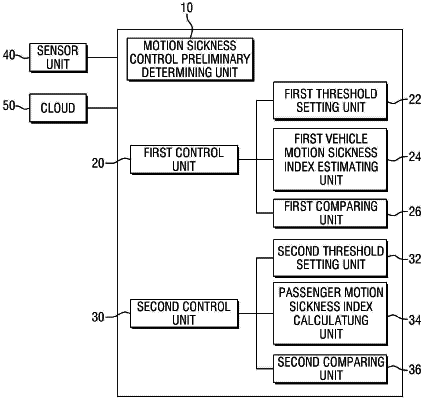| CPC B60W 60/0013 (2020.02) [B60W 30/143 (2013.01); B60W 40/08 (2013.01); B60W 2040/0872 (2013.01); B60W 2540/22 (2013.01); B60W 2540/221 (2020.02)] | 7 Claims |

|
1. A system for controlling an autonomous vehicle for reducing motion sickness, the system comprising:
a sensor unit configured to:
detect information about environments inside and outside the autonomous vehicle; and
recognize information about a passenger and information on behavior of the autonomous vehicle;
a cloud configured to store the information collected by the sensor unit;
a motion sickness control preliminary determining unit configured to:
receive the information about the passenger before travelling; and
determine whether to control motion sickness before travelling in advance by using the information about the passenger before travelling;
a first threshold setting unit configured to:
set a first threshold indicating the level of sensitivity to the occurrence of the motion sickness of the passenger according to the passenger information before travelling; and
store the first threshold in the cloud;
a first vehicle motion sickness index estimating unit configured to:
receive information about a target route from a departure point to a destination before travelling;
perform a travelling simulation according to the target route; and
estimate a first vehicle motion sickness index, wherein the first vehicle motion sickness index is defined as motion sickness causing energy generated by behavior of the autonomous vehicle while the travelling simulation is performed;
a first comparing unit configured to:
compare the first vehicle motion sickness index with the first threshold;
determine as the occurrence of the motion sickness is not predicted when the first vehicle motion sickness index is smaller than the first threshold; and
determine as the occurrence of the motion sickness is predicted when the first vehicle motion sickness index is larger than the first threshold, so that the first comparing unit generates a guide signal so as to guide the passenger to board the autonomous vehicle in a forward-facing direction rather than reverse-facing direction with respect to a direction of travel of the autonomous vehicle;
a second threshold setting unit configured to set a second threshold indicating the degree of sensitivity to the occurrence of the motion sickness of the passenger according to the passenger information during the travelling;
a passenger motion sickness index calculating unit, configured to:
calculate a passenger state index, wherein the passenger state index is computed by summing the degree of the occurrence of the motion sickness and each passenger state information to which a weighted value is assigned, and then dividing the summed value by a travelling time up to the present time;
estimate a second vehicle motion sickness index defined as motion sickness causing energy generated by the behavior of the autonomous vehicle for the travelling time up to the present time; and
calculate a passenger motion sickness index quantifying the degree of occurrence of the motion sickness of the passenger during the travelling using the passenger state index and the second vehicle motion sickness index; and
a second comparing unit configured to:
compare the second vehicle motion sickness index with the second threshold;
determine as the occurrence of the motion sickness does not occur when the second vehicle motion sickness index is smaller than the second threshold, so that it is not necessary to control the behavior of the autonomous vehicle; and
determine as the occurrence of the motion sickness occurs when the second vehicle motion sickness index is larger than the second threshold, so that the second comparing unit is to control the behavior of the autonomous vehicle to reduce or eliminate the occurrence of a frequency of shaking or vibration of the autonomous vehicle causing the motion sickness.
|